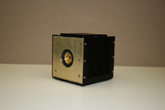Brain Interface: New Frontier?
This is MY project! And I don’t want to see it end up on some Defense scrap heap before we know what it’s really about!
– Brainstorm
The Intendix from Guger Technologies is a system that uses an EEG cap to measure brain activity in order to let you type with your thoughts, reports Engadget.
Meant to work with those with disabilities, Intendix is simple enough to use after just 10 minutes of training. You simply focus on a grid of letters as they flash. When your desired letter lights up, brain activity spikes and Intendix types it.
 Some people are able to type as quickly as 1 letter a second after minimal training. Besides typing, it can also trigger alarms, convert text to speech, print, copy, or email. It retails for €9000 (~$12,250), but it’s the first thought-to-type system that’s geared towards easy to setup personal use in the home.
Some people are able to type as quickly as 1 letter a second after minimal training. Besides typing, it can also trigger alarms, convert text to speech, print, copy, or email. It retails for €9000 (~$12,250), but it’s the first thought-to-type system that’s geared towards easy to setup personal use in the home.
New techniques for imaging the functional activity of the human brain (left) by simultaneously recording changes in its electrical activity (EEG) and blood flow (Functional MRI) are contributing important insights into normal and pathological brain functioning, says Electrical Geodesics in Eugene, Oregon.
Their Geodsic Sensor Net uses hundreds of senors to read brain waves. Current models provide 128 and 256 EEG channels. High resolution applications, such as for head tissue conductivity, and real-time detection of brain states require considerable high-performance computing (HPC) resources.
 Boeing’s cube-shaped 3D camera is one-third the size and uses one-tenth the power of most comparable 3D imaging cameras. Boeing is currently integrating the camera on unmanned aerial vehicles and will be testing that capability this spring. To create a 3-D image, the LiDAR camera fires a short pulse of laser light, then measures the pulse’s flight time.
Boeing’s cube-shaped 3D camera is one-third the size and uses one-tenth the power of most comparable 3D imaging cameras. Boeing is currently integrating the camera on unmanned aerial vehicles and will be testing that capability this spring. To create a 3-D image, the LiDAR camera fires a short pulse of laser light, then measures the pulse’s flight time.
Some analysts believe three-dimensional imaging will mean a major upheaval and overhaul of security systems in commercial, government and public use.
OpenCL (Open Computing Language) is a framework for writing programs that execute across heterogeneous platforms consisting of CPUs, GPUs, and other processors. OpenCL is analogous to the open industry standards OpenGL and OpenAL, for 3D graphics and computer audio, respectively. OpenCL extends the power of the GPU beyond graphics.
At SC09, nVidia was in everything. Nvidia says Tesla server clusters deliver 10 times the performance than CPU-based clusters while consuming less power. Their CUDA parallel computing architecture powers 240 parallel processing cores in each Tesla processor. At the show nVidia announced the Fermi featuring up to 512 CUDA cores. nVidia’s RealityServer brings complex 3D graphics to virtually any netbook or smartphone by crunching numbers on a server.
The OnLive streaming game service takes console and PC games, renders them server-side, then streams it to you. It will go live on June 17.
You know who has some great 3D map models…Visual Complexity.
It’s all about The Cloud.
source : dailywireless.org






No comments:
Post a Comment